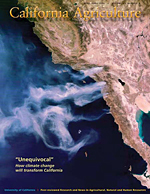All Issues

“Unequivocal” - How climate change will transform California
Cover:
In its 2007 report, the Intergovernmental Panel on Climate Change concluded that climate change is “unequivocal.” Wildfires are expected to become more commonplace in California, consistent with the predictions of climate-change models. Twelve large wildfires — fueled by the powerful Santa Ana winds that pushed flames through brush and grass dried from drought — raged in California on Oct. 23, 2007, clouded the air over the Pacific Ocean with dense plumes of smoke. Photo: NASA image by Jeff Schmaltz, MODIS Rapid Response Team, Goddard Space Flight Center





